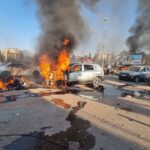The situation in South Korea, marked by President Yoon Suk Yeol’s declaration of martial law, reflects deep political divisions. Tensions between the government and opposition parties have intensified over budget disputes and governance issues. The move has sparked protests and drawn international attention. The outcome will depend on public reaction, potential compromise, and the military’s adherence to constitutional limits. This crisis has implications for South Korea’s domestic stability and its regional and global relationships, especially with North Korea and its alliance with the U.S.
South Korea is experiencing political upheaval as President Yoon Suk Yeol declared martial law, citing threats to the nation’s democracy from “anti-state forces” linked to opposition activities. This move followed intense disputes in parliament over budget allocations and has led to protests, with opposition leaders calling the measure illegal and urging public demonstrations. The military has heightened its readiness, and parliamentary access has been blocked. The situation is drawing international concern, including from the U.S., which is monitoring developments closely.
President Yoon Suk Yeol declared martial law in South Korea, claiming it was necessary to protect the country from “anti-state forces” within the opposition. He accused opposition leaders of undermining democracy by obstructing governance through impeachment efforts and budget disputes. The move aims to restore order amid heightened political tensions and public dissatisfaction with his administration. Critics, including opposition leaders, have called the declaration illegal and a misuse of power, urging protests to challenge it.
While South Korea’s declaration of martial law has raised concerns about political instability, a coup is unlikely. South Korea has a robust democratic system, strong institutions, and a history of public resistance to authoritarianism. The military’s role in a modern democracy, coupled with international alliances, especially with the U.S., further diminishes the likelihood of a coup. However, the situation remains tense, with opposition leaders and public protests challenging the martial law declaration, creating political uncertainty.
The conflict between South Korean President Yoon Suk Yeol and the opposition stems from political and economic disagreements. Key issues include a disputed national budget, with the opposition cutting proposed funds for key government institutions, and allegations of corruption and mismanagement by both sides. The opposition accuses the president of authoritarianism and undermining democracy, while Yoon blames the opposition for legislative gridlock and shielding leaders from legal accountability. These tensions reflect broader dissatisfaction with governance and economic challenges in the country.
There is no direct evidence of North Korean (DPRK) involvement in the recent developments in South Korea, such as the declaration of martial law or the political conflict. However, President Yoon has cited North Korea’s potential threats as part of the justification for imposing martial law, framing the opposition’s actions as undermining national security. The situation primarily appears to be a domestic political crisis, though North Korea remains a background concern in South Korea’s security calculations.
The declaration of martial law in South Korea could potentially benefit President Yoon Suk Yeol by consolidating his authority and suppressing opposition activities that he claims are destabilizing the country. By framing the opposition as “anti-state forces,” Yoon aims to position himself as a defender of national security and democracy. However, this move risks backfiring, as it has sparked public protests and intensified criticism of his leadership. The long-term impact will depend on how the situation evolves and public sentiment towards his administration.
The declaration of martial law in South Korea opens several possible scenarios:
- Government Consolidation: President Yoon could use martial law to restore order and pass his policies, potentially quelling opposition but at the cost of heightened public discontent and potential international criticism.
- Escalation of Protests: Large-scale public demonstrations could force the government to reconsider martial law, risking a loss of legitimacy.
- Opposition Gains Momentum: The opposition could leverage public dissent to challenge the president’s authority, possibly leading to impeachment attempts or snap elections.
- South Korea’s opposition primarily represents progressive and centrist societal groups, including workers’ unions, younger urban voters, and advocates for social justice and transparency. It draws support from those critical of President Yoon Suk Yeol’s conservative policies, handling of economic issues, and perceived authoritarian tendencies. The Democratic Party of Korea, the main opposition, has significant backing from individuals who favor engagement with North Korea and emphasize welfare policies over corporate or military priorities.
- Compromise or De-escalation: Mediated dialogue between the government and opposition might lead to the lifting of martial law and a return to normal political processes.
The outcome will hinge on public reaction, the role of South Korea’s judiciary, military adherence to constitutional limits, and international responses.
The political turmoil in South Korea could have ripple effects on regional stability in several ways:
- Weakened Domestic Focus: Internal instability may limit South Korea’s ability to respond to North Korean provocations or participate actively in regional diplomacy.
- Impact on U.S. Alliances: As a key U.S. ally, a distracted South Korea could alter regional security dynamics, affecting joint military readiness or cooperation.
- Economic Effects: Prolonged instability could disrupt South Korea’s economic activities, impacting trade partners and supply chains in Asia.
The region’s stability depends on how quickly South Korea resolves the crisis.
Various political groups, both domestic and international, might have interests in South Korea’s turmoil:
- Domestic Opposition: South Korea’s opposition parties could leverage the unrest to challenge President Yoon’s administration, potentially seeking political gains or changes in leadership.
- North Korea: The DPRK might see the instability as an opportunity to exploit a distracted South Korean government, escalating provocations or propaganda.
- Regional Rivals: Countries like China may observe closely, as South Korea’s instability could weaken its alliance with the U.S. or disrupt regional balances.
Each group’s goals depend on their strategic interests.




